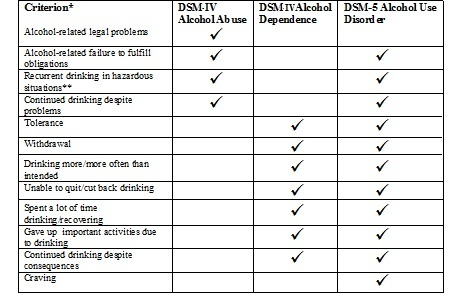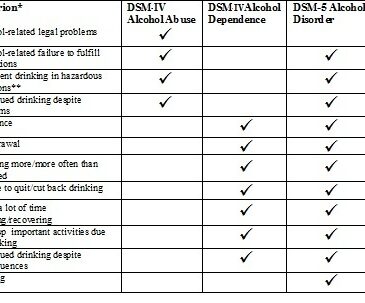Imagine a man who drinks in dangerous situations, such as when driving, but doesn’t meet any other criteria for alcohol use disorders. According to the DSM-IV, this man is experiencing alcohol abuse. The DSM-IV separates alcohol use disorders (AUDs) into alcohol abuse, characterized by serious negative consequences due to drinking, and alcohol dependence, characterized by physical symptoms related to drinking (APA, 1994); it also requires only one criterion for a diagnosis of alcohol abuse. However, under the new DSM-5 guidelines scheduled to be released this month, our hypothetical man’s diagnostic situation would change. The DSM-5 does not make separate diagnoses for alcohol abuse and dependence but makes a single diagnosis of AUD along a severity continuum and requires a minimum of two criteria. In addition, the DSM-5 substitutes a current criterion related to legal consequences of alcohol for a new criterion related to alcohol craving. This week the DRAM reviews a study that investigated how these potential changes will affect diagnosis and prevalence of AUDs (Agrawal, Heath & Lynsky, 2011).
Methods
- Researchers used Wave II data from 34,653 respondents to the National Epidemiological Survey on Alcohol and Related Conditions (NESARC) (Grant et al, 2004).
- NESARC used the Alcohol Use Disorders and Associated Disabilities Schedule (AUDADIS-IV) to collect information about both DSM-IV and DSM-5 alcohol use disorder criteria (Grant et al., 2003). Criteria included:

* Each criterion is represented by one to three AUDADIS items
** Includes an item measuring drinking and driving.
Results
· 9.7% of NESARC Wave II respondents qualified for alcohol abuse or alcohol dependence (DSM-IV), while 10.8% of the sample qualified for an AUD as defined by DSM-5.
· As shown in the Figure, 1,033 people who did not qualify for alcohol abuse or alcohol dependence according to DSM-IV criteria qualified for an alcohol use disorder according to DSM-5 criteria. All of these were classified as having a moderate AUD.
o Only 16.1% (n= 166) of these respondents endorsed the new DSM-5 “craving” criterion.
· A total of 659 people who qualified for alcohol abuse or alcohol dependence according to DSM-IV criteria did not qualify for an AUD according to DSM-5 criteria.
o The overwhelming majority of these people (96.5%; n= 636) endorsed the criterion for drinking in hazardous situations, in particular an item measuring drinking and driving.
Figure. Diagnoses of AUDs according to DSM-IV and DSM-5 in the NESARC Wave II Sample (adapted from Agrawal, Heath & Lynsky, 2011) Click image to enlarge.
Limitations
- As with any survey that relies on self-report, it is possible that the answers did not accurately reflect actual behavior or symptoms.
Conclusions
The changes in the DSM-5 had a modest positive effect on the prevalence of AUD , though the addition of the craving criterion did not play a major role in this re-classification. Those who met criteria for AUD under DSM-IV but not under DSM-5 were most likely to endorse the criterion for drinking in hazardous situations. This, combined with the fact that the DSM-5 requires a minimum of two criteria, means that people like the man described above switch from a diagnosis of alcohol abuse to no diagnosis at all. Under DSM-5, these individuals could lose important treatment resources. In addition, there is still debate about whether alcohol abuse and alcohol dependence are two fundamentally different disorders that require different treatment approaches; by condensing them into one, we may lose some important information. Finally, future research might focus on further refining and exploring the divisions of “moderate” and “severe” AUD within DSM-5 diagnoses.
-Katerina Belkin
What do you think? Please use the comment link below to provide feedback on this article.
References
Agrawal, A., Heath, A.C., Lynsky, M.T. (2011). DSM-IV to DSM-5: the impact of proposed revisions on diagnosis of alcohol use disorders. Addiction, 106, 1935-1943.
American Psychiatric Association (1994). Diagnostic and Statistical Manual of Mental Disorders, 4th edn, revised. Washington, DC: American Psychiatric Association.
Grant B. F., Dawson D. A., Stinson, F. S., Chou, S. P., Dufour, M. C., Pickering R. P. (2004). The 12-month prevalence and trends in DSM-IV alcohol abuse and dependence: United States, 1991–1992 and 2001–2002. Drug and Alcohol Dependence, 74, 223–34.
Grant B. F., Dawson D. A., Stinson F. S., Chou P. S., Kay W., Pickering R. (2003). The Alcohol Use Disorder and Associated Disabilities Interview Schedule-IV (AUDADIS-IV): reliability of alcohol consumption, tobacco use, family history of depression and psychiatric diagnostic modules in a general population sample. Drug and Alcohol Dependence, 71, 7–16.





